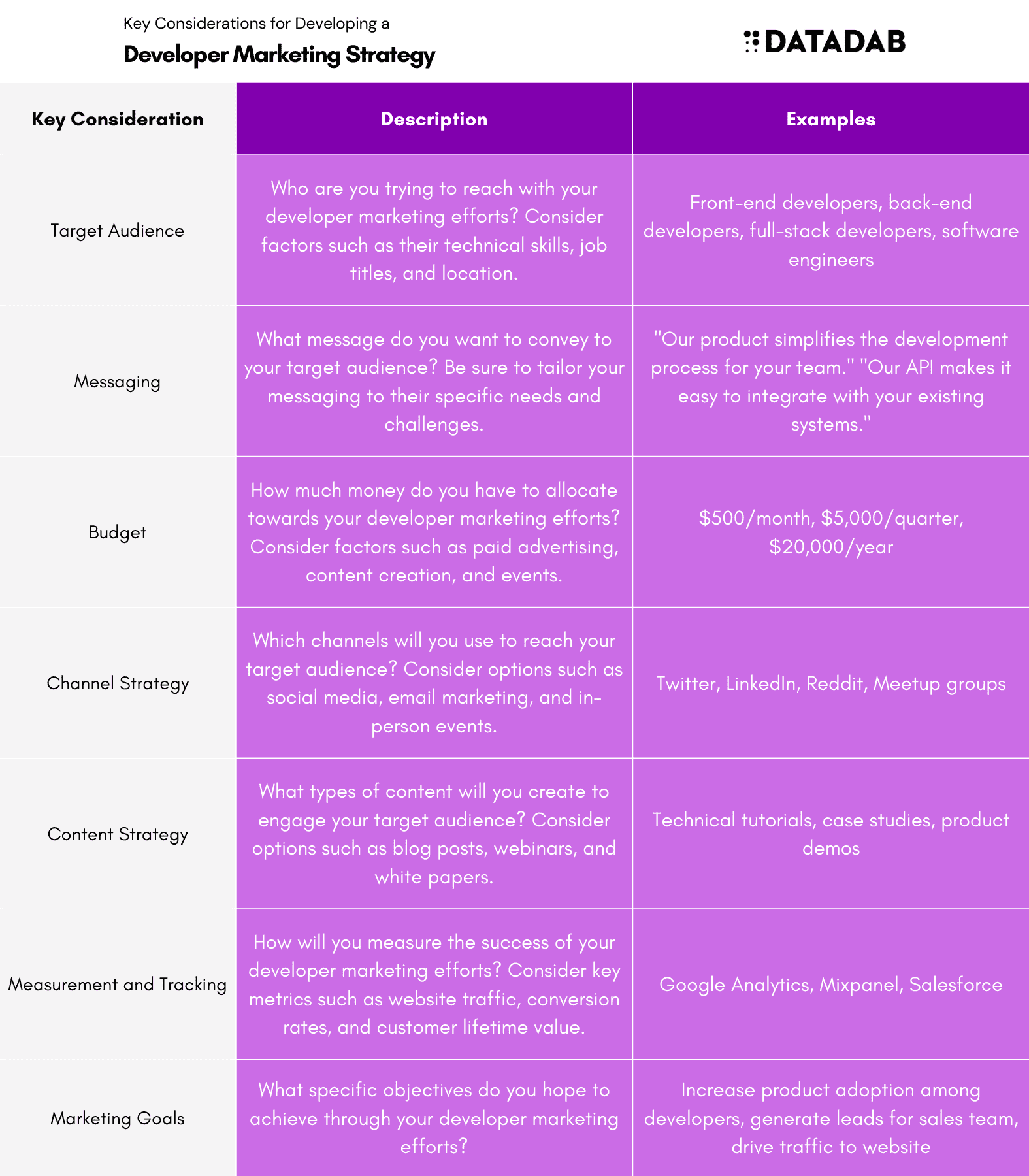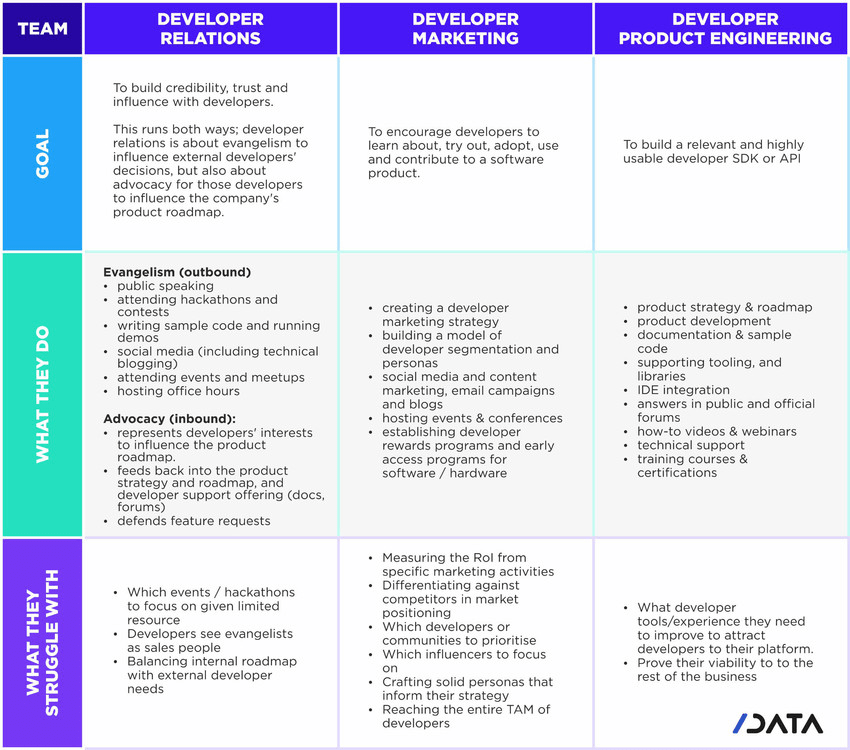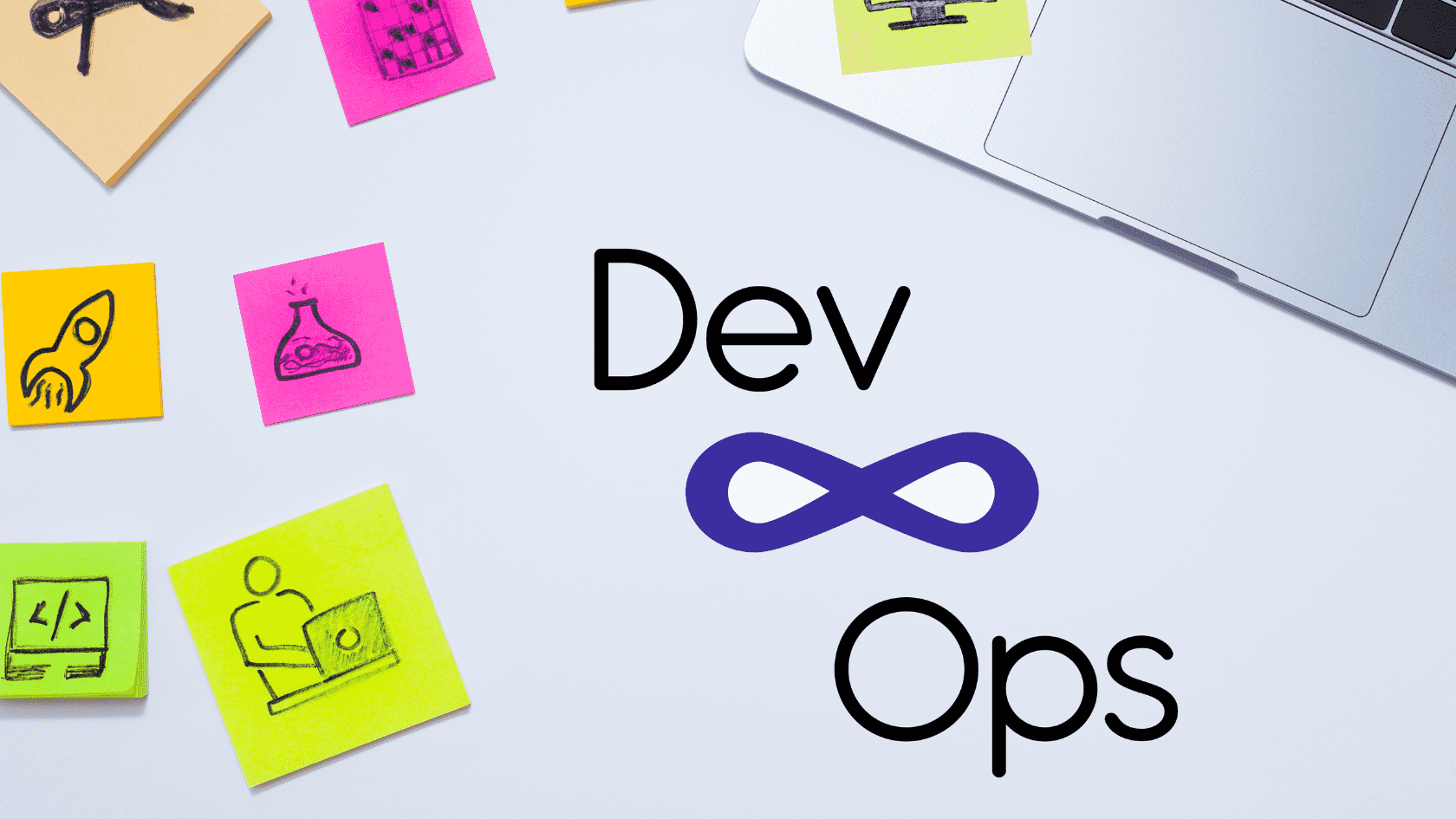"Marketing to developers requires a different approach than marketing to consumers. Developers are highly analytical, technically savvy, and prioritize functionality and utility over aesthetics and hype."
We work with many SaaS companies who are building innovative solutions but struggle to effectively promote them to the developer community. The developers we interact with are a skeptical bunch - they see through marketing fluff and desire straight talk from people who understand their needs.
After years of trial and error, my agency has found what works to capture developers' attention and excite them to try new tools. The key is speaking their language through detailed documentation, open APIs, live coding tutorials, collaborations with dev-trusted partners, and case studies quantifying real-world impact. We’ve seen how vital elements like these remove friction from the evaluation process and build authentic trust. My goal is to distill our hands-on lessons into an actionable blueprint for SaaS brands on how to craft an empathetic developer marketing strategy that actually converts. The developer community can be a hard nut to crack, but they also represent enormous opportunity for products able to seamlessly integrate into developers’ workflows. I’m thrilled at the chance to help more businesses successfully court this lucrative yet elusive audience.


What is developer marketing?
Let’s say you are entrusted with marketing for a high-tech product. But it’s not a consumer app. It’s a set of ready to use APIs meant for messaging media like SMS, voice, and video. Who do you think you should be targeting?
It’s the software developers of various consumer and enterprise-level apps you would like to target. Because they are the ones who need a ready to use messaging solution that they can simply integrate in their own tech products. The marketing tactics you’ll use to market those APIs effectively are what you’d do if you are a developer marketing guy or girl.
The most straightforward definition of developer marketing is that it is a form of marketing intended to target and capture software developers’ attention. Easier said than done, though. The community of developers is so fragmented and so private that marketing to them is altogether a different animal. The usual ways of marketing that otherwise work well in B2B or even B2C do not work here.
A new term had to be coined to address this form of marketing, commonly known as B2D marketing or business to developers marketing.
A sales team will reach out to executives in a B2B setup or consumers directly in a typical B2C business. In the case of B2D marketing, however, the focus of interaction shifts to developers who use API based platforms to power their software products at scale. It is not that developers are not consumers, they certainly are, but they behave entirely differently from your average customer.
Expect them to be far more apprehensive and analytical. Most of them tend to be relatively reserved and dislike the general idea of being marketed and absolutely loathe the pushiness of traditional sales models and advertising.

Developer marketing means thinking and being like developers. Most developers are always researching and learning about the latest approaches and techniques. Chances are, they already have a pretty good understanding of what's out there, what is working out well, and what’s not. It is common for them to test and use new technology, identify problem areas, work around them, and share results later within their dev communities. They need to see the latest tech innovations in action and play with them in low-risk environments before installing them in their core stacks.
What is developer relations?
This is another question that we get asked a lot. Is developer relations (dev relations) the same as developer marketing?
Dev relations is not precisely developer marketing. It is the means to an end. The objective is to obviously market a tech product eventually to the developers by establishing a thriving community.
The developer relations department has two distinct workflows. The critical component of their duty is evangelism: meaning spreading the company's message to outside developers. You can find them describing what features of their product are available and what are not yet.
The other aspect of their work is advocacy: articulating users’ opinions back to the development team. Dev relations guys can often be seen defending or even arguing with the development team with unique feature requests. The requests that come directly from their target user base.
It's a significant responsibility and requires a delicate balancing act. You will be promoting the product on behalf of the business and evangelizing the product to developers.
They are responsible for creating relationships, then stepping back and letting others do their work. For instance, they might bring a community member to their recruiter or introduce a super active and skillful community member to the marketing department to write a blog piece. The developer relations' work is not tangible in terms of revenue, promotions, or conventional industry metrics.



Why is developer marketing so challenging?
We established earlier; the developer community hates being marketed to. They are typically more knowledgeable and tech-savvy than other types of customers and business leaders. Developers can sense frivolous advertising from miles away, eventually resorting to derogatory connotations and company mistrust. Theirs is a much more narrow group with a cynical outlook and more especially averse to marketing jargon.
Developers are not your only audience. One of the mistakes dev marketers commit when engaging with developers is not entirely understanding the developers is just one part of the marketing riddle. Although developers are end-users of your APIs, they are generally only one function in a multidisciplinary team. Marketing and messaging meant for a developer will not be ideal for a sourcing or project director, or vice versa.
The developer community is super fragmented. There is no single platform that you can find them all in one place (so that you can conveniently start a targeted campaign). There are micro-communities like subreddits, discord channels, quora, stack overflow, etc where you can find them. And all these platforms have their own sets of cultures (read hurdles) to deal with.
Unlike traditional markets, users here prefer to access content all at once (or maybe none at all), like Netflix binge-watching. That means drip emails turn out to be not that effective if not done correctly.
The developer marketing plan that works
The who, what and why?
So far, we have seen that developers are a highly technical audience; they tend to be younger; and they are mostly male, although this demography is beginning to shift lately. Developers don't like marketing jargon; they appreciate straight, frank talk from someone who knows the subject and understands the issues that developers face daily. Let us expand upon the topic of our target audience while we are at it.

We can't stress enough how important it is to answer the question "Who's the target audience" as descriptive and as vividly as possible. There could be not just one but a variety of distinct user personas that you should be targeting. There's a world of decision-makers you are not familiar with. Remember, even though it’s software developers who you might be targeting as they are going to be the end-users. They are not, however, the actual decision-makers. They are in the loop to take the decision to go ahead with a new tech along with a slew of sales and marketing executives. Keep a note of that. While you are building a great community of developers who are raving about your product’s awesomeness, make sure to educate them well about the potential business benefits of going with the product. So they can advocate it so that they can champion for your product in their respective companies’ committees.
A documented survey is a perfect way to refine the audiences and then interviews are useful. I see a ton of marketing professionals who don't find the need to speak with a real customer.
Coming back to the question of issues your product fixes. The problems you tackle now may not be the problem you plan to fix for your business or customers in the future. While marketing your product, think long term. Think for the long haul. How do you build that narrative? How do you construct the path of issues and solutions? Are you going to develop the messaging around the solution, or should you instead focus on highlighting the problem first? Today you could solve just one distinct unique challenge, but be ready with a plan AND a story to deal with a multitude of such challenges.
Newsletters and drip campaigns
Newsletters are a solid starting point for communication. If you have no other channel set up, you should have a newsletter. There are some excellent tools out there like Mailchimp and Active Campaign. You can also use them to set up an email drip campaign. Once your email list starts growing, you should start segmenting users by demography, company type, levels of responsibility in their companies, or any other parameter you think is essential. Keep a close eye on what content users click on and try to use more of that kind. Please make sure your email looks polished and professional. If the emails are not even responsive or the fonts and colors are off, people are never going to open it the next time.
Check out these neat-looking open-source HTML email templates.
Test your emails thoroughly. Have people from your team or other teams read the email copy. And always do A/B testing on your campaigns so that you know what is working and what is not. Use a variety of subject lines, pictures, or mailing times to figure out what's effective for the audience.

If your email copies don't do well, use the insights to do better the next time. Look at your successful email campaigns and extend those lessons to other marketing activities.
If you are looking for some ideas, check out these onboarding email templates.
And last but not least, please do not send a ton of emails. Send only when you have something worthwhile to share or when it’s an onboarding or transactional email. You don’t want your emails to land up in spam folders. Avoid these spam trigger words. Don't forget to authenticate your domain by setting up DKIM, SPF, and DMARC.
Open-source APIs and SDKs with rich documentation
An open or public SDK or API can be incredibly beneficial in the product assessment process for your target customers, as it improves clarity on purchasing decisions. Questions that the developers and their business leaders might have, like: Does this product or solution meet our requirements? How complicated is integration? What kind of support and services are offered with the product?
Slack is lauded for its developer-friendly, functional and open API. If you can’t make the API’s public, consider making it super easy to use. Rich, vivid documentation is a step in the right direction.
What to blog
Find out what works in the same space for other companies. Tracing your rivals' content's social traction and details like what categories and kinds of content are getting most of the shares, what content types are getting the most engagement will give you a lot of insights. This tactic can even be applied to tech news publications like Mashable, TechCrunch, Wired etc
Many businesses showcase a gallery on their website to demonstrate their integrations and collaborations with other major 3rd party products. You can consider writing some content about how your customers personalized the platform or developed integrations.

One evergreen tip we can offer is to create comparison articles. Articles comparing different products or technology often do very well. Writing this type of content is pretty simple too. The trick here is to look for those products that support integration with your product’s APIs so that you can then add a line or two about how easy it is to integrate X or Y with your product.
We at DataDab use this tool called AnswerThePublic for generating our content ideas. This tool taps into autocomplete data from search engines like Google, and instantly provides all relevant terms and phrases people inquire with your keyword. It's a treasure trove of consumer insight that you can use to create fresh, useful content; the type customers are themselves looking for.
Use content marketing as a tool to assist prospects learn more about your product. The same content will eventually pave the way to your pricing page.
On an average your target audience takes seven different messages/interactions to respond to your message finally. Those seven interactions could come from your Tweets, emails, videos, webinars, or old trade shows. To increase these odds of getting a response, we suggest repurposing your content. One article may be repurposed into numerous tweets, presentations, on-stage lectures, audio, or video clips, documents, ebooks, etc. Each content format allows us to leverage an altogether different platform.
Email Template for Developer Outreach
Subject: Join our developer community
Hi [Developer Name],
I'm [Your Name] from [Company]. We're building a developer community for our [product/API name] and would love for you to join.
As a member, you'll get:
- Early access to new features and updates
- Invitations to online events, meetups and hackathons
- Opportunities to connect with our engineering team
- Access to documentation, code samples and SDKs
If you're interested in learning more, sign up here [link]. We can't wait to connect!
Let me know if you have any questions.
[Your Name] [Your Title] [Company Name]
Get help from the Devs themselves.
It's a known fact, and we've established that developers just don't trust salespeople or marketers. They trust developers, though. So look for ways to leverage your technical team's technical expertise here. Prod your subject matter experts to conduct workshops or live coding sessions on YouTube, GitHub, or even Reddit to increase product recognition, walkthrough of features, and various use cases. Guest posting on developer-focused sites, like DZone, also enhances your brand's reputation.

Another way to win confidence from developer-to-developer is to seek ad collaborations with developer-trusted sites. Such niche platforms also offer ad impressions for less than Google Adwords and other advertising platforms and are more tailor-made for your requirements.
Product Discovery Platforms
Product discovery sites such as G2 Crowd, Capterra, Product Hunt, stackshare, Slant, etc, provide significant results without much effort. Programmers are highly intelligent and diligent in identifying the most appropriate resources for their technical requirements.

By adding your product on these sites, you make it easy for developers who are actively seeking new tools like yours. Listing on an independent website with relevant feedback from your customers is a robust way of winning trust from prospects. Plus, a free back-link will always help you in SEO.
Case studies
Remember, when we mentioned that developers are just a part of the equation in customer segmentation. There is also a group of senior executives who need to be convinced that it’s wise to go with your product. For that to happen, your target audience(the developers) should be equipped to present your case favorably. And here is where the case studies are going to be incredibly useful.

The C Suite and the Execs just want to know if the product has already been implemented in a similar kind of environment, preferably in similar types of organizations, and what was the business outcome of doing that implementation, quantitatively speaking?
So invest some time in creating case studies covering customers from all the major industries and business segments that generate revenue for your company. Focus on making it balanced. It is not a whitepaper. Technical and business aspects both should be there. If possible, try to add a tangible business outcome in the case studies.
Let us know what your approach is toward developer marketing!
Additional Ideas
to make your Dev Marketing efforts effective
Leverage video content
Create a series of short videos demonstrating core product capabilities and flows - sending an API request, implementing authentication, handling responses etc.
Release video tutorials for complex topics like migrating from REST to GraphQL or debugging errors. Use real-life examples that developers can relate to.
Live stream coding sessions on Twitch where your developers build a sample app using your APIs and SDKs from scratch. Developers can follow along and interact.
Highlight security
Create a security best practices guide for your API - authentication, authorization, TLS, input sanitization, rate limiting etc.
Share results of independent security audits and penetration testing to build trust. Highlight compliance with regulations.
Make security features prominent in docs. Explain threat models, defend against common attacks like DDoS, XSS, SQLi.
Spotlight automation
Provide code samples to help developers automate repetitive tasks - generating reports, importing data, deploying code.
Build integrations with popular automation tools like Zapier, IFTTT, Apache Airflow.
Highlight automation use cases in action - "How Company X automated order processing with OrdersAPI"
Connect through communities
Have developer advocates actively engage in forums like Reddit's r/webdev, r/programming. Provide assistance, share insights.
Create screencasts showing how to integrate your APIs into sample GitHub projects and deploy to Vercel, Netlify.
Sponsor hackathons on platforms like Devpost. Provide APIs, resources and mentorship for hackers. Offer prizes.
Align with developer priorities
Benchmark performance against competitors. Share metrics like response times, uptime, scalability.
Allow flexible authentication - API keys, OAuth, social login, biometrics. Don't impose restrictive usage limits.
Provide multi-language SDKs, ideally in languages matching your target demographics.
Leverage influencer advocacy
Identify recognized independent developers/bloggers in your domain. Provide access for testing your product and creating content.
Work with developer experts to create videos featuring product integrations tailored to their audience.
Repost/highlight credible 3rd party reviews and tutorials on your own channels. Quote and link back.
Optimize for search
Research keywords developers search for a feature your product offers. Optimize pages and content for those keywords.
Structure docs/blogs to target buyer keywords - "docs api", "pdf api", "api tutorial". Provide code samples.
Ensure SEO basics - site speed, mobile-friendly, sitemaps, alt text, metadata, backlinks. Monitor traffic sources.
Streamline the onboarding
Offer instant Sandbox accounts to immediately test APIs without authorization.
Provide interactive docs allowing developers to send test requests, toggle parameters and view responses.
Automate provisioning and API key generation to get developers started in minutes. Offer in-dashboard chat support.
Integrate platforms and tools
Build plugins for IDEs like VSCode, Android Studio to simplify discovering, using your APIs.
Provide CLI integration so developers can call your APIs from terminal. Share scripts to automate workflows.
Offer out-of-the-box integrations for platforms like Slack, Postman, GitHub by leveraging their APIs and UI options.
FAQs
How to do marketing to developers?
Marketing to developers can be challenging, but it's not impossible. To reach this tech-savvy audience, you need to understand their mindset, speak their language, and provide value. Here are a few tips to help you get started:
- Understand the developer mindset - Understand their pain points, goals, and workflows.
- Show, don't tell - Use demos, videos, case studies, and live webinars to show developers how your product can solve their problems.
- Leverage influencers - Get thought leaders in your industry to talk about your product.
- Participate in developer communities - Provide value to the community by answering questions, providing solutions, and sharing knowledge.
Why is developer marketing important?
Developer marketing is important because developers are the gatekeepers of technology adoption within an organization. They are the ones who decide which products to use and which to ignore. By reaching out to developers and providing them with the information they need to make an informed decision about your product, you can increase the chances of your product's adoption.
What is B2D marketing?
B2D (business-to-developer) marketing is a term used to describe the process of reaching out to developers and convincing them to adopt your product. This can include a variety of activities, such as creating content for developers, participating in developer communities, and leveraging influencers.
What is the role of developer relations?
Developer relations is the practice of building and maintaining relationships with developers. This can include a variety of activities such as creating content for developers, participating in developer communities, and providing support and resources to help developers use your product more effectively. Developer relations aim to create a positive relationship between your company and the developer community, which can lead to increased product adoption and advocacy.
How to create content that appeals to developers?
Creating content that appeals to developers requires understanding their pain points, goals, and workflows. Here are a few tips to help you create content that will resonate with developers:
- Use technical jargon - Speak the same language as your audience to build trust.
- Provide solutions - Give developers practical information they can use to solve problems.
- Use case studies - Show developers how your product has helped other companies solve similar problems.
- Leverage data - Use data and statistics to back up your claims.
How to use social media for developer marketing?
Social media is a powerful tool for reaching developers. Here are a few tips for using social media to market to developers:
- Use relevant hashtags - Use hashtags that are popular within the developer community.
- Engage with developers - Respond to comments, answer questions, and participate in conversations.
- Share technical content - Share articles, videos, and other content that will appeal to developers.
- Leverage influencers - Get thought leaders in your industry to share your content.
How to measure the success of developer marketing?
Measuring the success of your developer marketing efforts can be challenging, but there are a few key metrics you can use to gauge your progress:
- Product adoption - Track the number of developers who are using your product.
- Engagement - Track developers' engagement levels on your website and social media channels.
- Referral traffic - Track the number of visitors to your website who come from developer communities.
- Brand awareness - Track the number of developers who are aware of your brand.
How to Sell to Developers
To reach this tech-savvy audience, you need to understand their mindset, speak their language, and provide value. Here are a few tips to help you get started:
- Understand the developer's buying process - Understand the steps that developers go through when making a decision to buy a product. This will help you create a sales strategy that is tailored to their specific needs.
- Provide a free trial - Give developers the opportunity to try your product before they buy. This will help them make an informed decision and increase the chances of them choosing your product.
- Leverage case studies - Show developers how your product has helped other companies solve similar problems. This is a great way to demonstrate the value of your product.
- Build relationships - Building relationships with developers is key to selling to them. Provide them with the resources and support they need to be successful with your product.
Developer Marketing Conference
Developer marketing conferences are a great way to stay up-to-date on the latest trends and strategies in the industry. These conferences typically feature keynote speakers, workshops, and networking opportunities, providing attendees with valuable insights and connections. Some of the top developer marketing conferences include:
- DeveloperWeek
- DevRelCon
- DevXCon
- DevRelSummit
Attending these conferences can be a great way to learn from experts in the field and gain valuable insights into the latest trends and strategies in developer marketing.
Developer Marketing Channels
There are a variety of channels that can be used to reach developers, including:
- Social media - Platforms like Twitter, LinkedIn, and GitHub can be used to reach developers and build relationships with them.
- Content marketing - Creating valuable content like blog posts, videos, and webinars can help you reach developers and demonstrate the value of your product.
- Influencer marketing - Leveraging thought leaders in your industry to talk about your product can help you reach a larger audience and build credibility.
- Community building - Participating in developer communities can help you build relationships and increase brand awareness.
Best Developer Marketing Campaigns
There are many great developer marketing campaigns out there, but here are a few that stand out:
- GitHub's "Code is Poetry" campaign - This campaign used poetry to convey the beauty and elegance of code, resonating with developers and showing GitHub's understanding of their audience.
- Stripe's "Developers First" campaign - This campaign communicated Stripe's commitment to putting developers first, resonating with the developer community and building trust.
- AWS's "Start-Up Stories" campaign - This campaign featured real-life success stories of start-ups using AWS, demonstrating the value of their product and inspiring developers to consider using AWS for their own projects.
These campaigns were effective because they understood the developer audience, spoke their language, and provided value.







